-
Posts
6,486 -
Joined
-
Last visited
-
Days Won
10
Content Type
Profiles
Forums
Blogs
Gallery
Events
Store
Posts posted by Brian Wolfe
-
-
Hello everyone,
During the British Raj there existed literally 100s of independent states within India ruled by a Maharaja or other ruler. These states where usually in an alliance with the British and thereby were free from direct rule by the British. This is a very simplified statement and you should research into the topic more for more detailed and accurate information. In a nut shell, it was a matter of get along with the British Raj or your country might just get along without you.
The followwing photos are of the Maharaja of Patiala,Sir Bhupinder Singh Mohinder Bahadur who ruled from 1900 until 1938. Following the photos are some medals so hang in there for those and a bit more of the history of Patiala after Indian Independence in 1947.
Regards
Brian
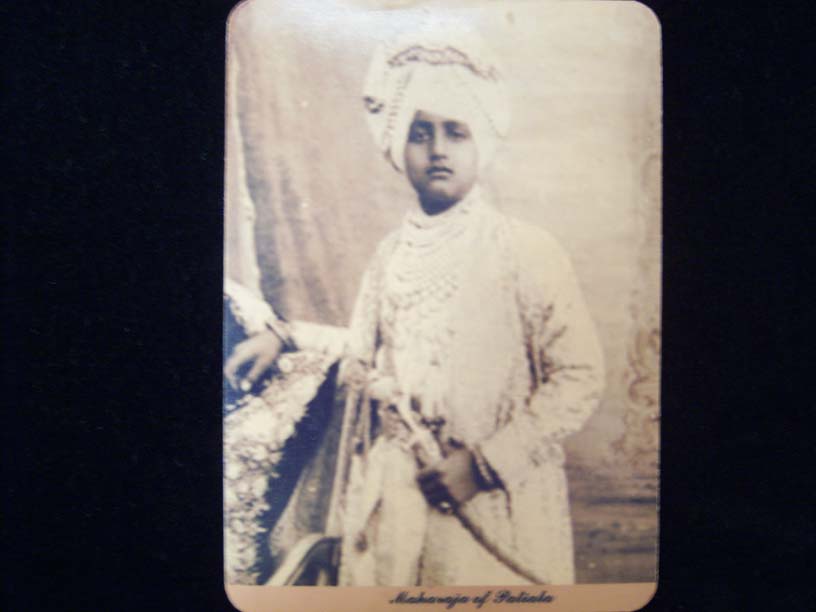 0
0 -
My final photo is of the sight displayed in my collection room along side my German artillery sight and a pair of French binoculars from around 1908.
Regards
Brian
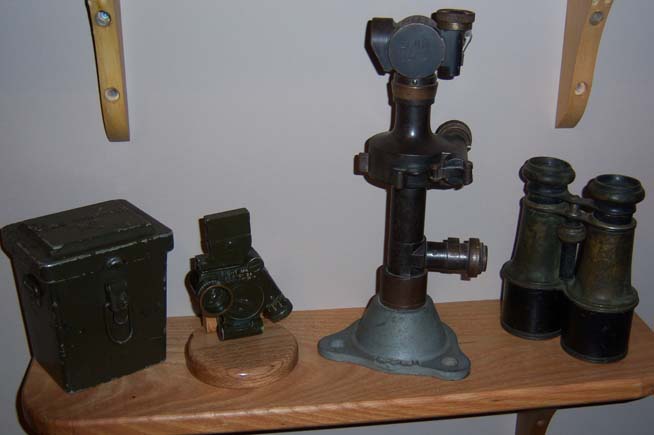 0
0 -
Here's a view of the rear of the stand. I cut a dovetail to fit the tapered dovetail of the sight and the locking lever actually locks the sight onto the stand as it would on the mortar.
Brian
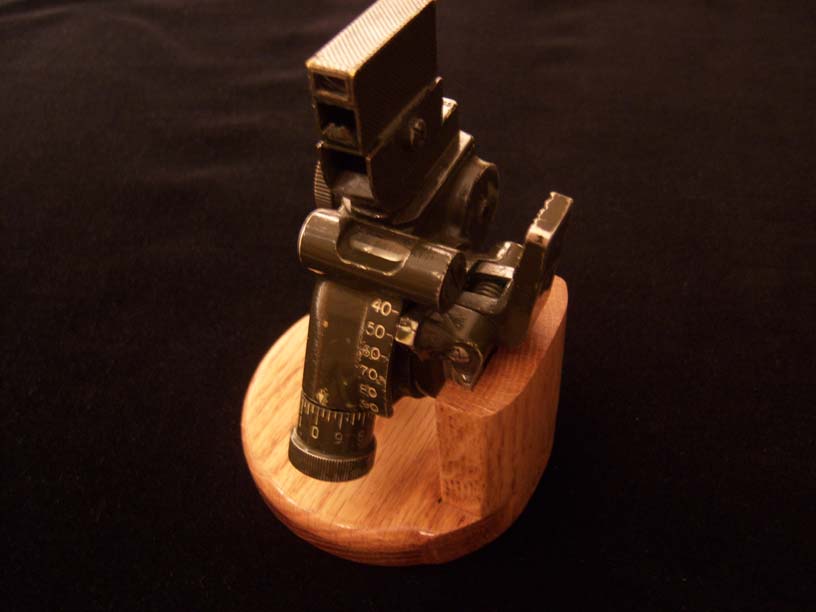 0
0 -
Hello Everyone,
I thought I'd complete this post with a view of the stand I built to display the sight. I was looking around my shop and found a couple of pieces of red oak scrap and put them to better use. The whole stand is well coated with a clear-coat keeping the oak well away from the metal parts. I hope you like it.
Regards
Brian
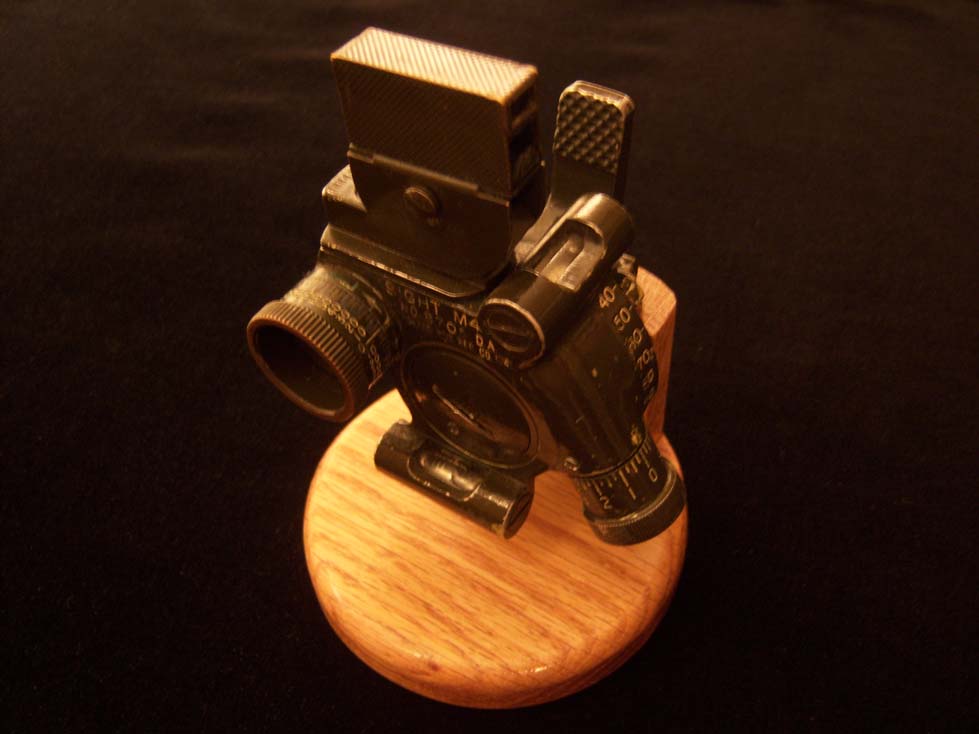 0
0 -
Hi Ed,
That really is an unusual item. When I collected patches and travelled to the local shows I don't think I remember ever seeing one offered. Here, in my part of Ontario, Canada, the Regional Police have there own sign shop or perhaps they share it with the Region's Utilities and Works Department. When I have been in the shop for city decals and signs, years ago, I've seen these ready to ship...if only I had thought about adding one to the collection!

Nice piece.
Regards
Brian
0 -
Brian
An interesting collection but you are a little out with your background. Special Constables were first mentioned in an Act of Parliament in 1673. They were used on and off as needed for 'Riot & Tumolt' situations until just before WW1 un-uniformed but often in very large number, 200,000 were sworn in on Kennington Common for the 1848 Chartist Marchers. Just before WW1 the SC was put on a more formal footing (City of London formed a standing force in 1909) and uniformed in 1916, probably your first poto is about that time. The SC was stood down after WW1 but promptly reformed (?1920/21) after the regular police went on strike in 1919. From the reforming until 1935 the title was Special Constabulary Reserve, the word Reserve was then droped. At the start of WW2 there was a massive increase in numbers and a shortage of uniforms so back to arm bands for some. The 'royal' Long Service Medal was/ is awarded for 9 years peace time service/ 3 years war time service and the bar for each further 10 years service. The minature in one of your pictures is probably one from Spinks or a competitor as minatures have never, as far as I am aware, been officially issued.
Thanks again for the additional information, this is perhaps the greatest strength of the GMIC. As far as my collection it starts with the Great War period, of course. Am I to take it that the first full time service started due to the war and before that it was ad hoc?
Regards
Brian
0 -
Brian
This will be a Charity Pin possible issued by one of the CoLP sports clubs or the Police Federation Branch. I have not seen this one before but there have been several issued by the Regualr force and the Special Constabulary. The sword on the shield is a City Of London emblem/ coat of arms.
Many thanks Vickers and welcome to the GMIC.
Regards
Brian
0 -
Hi Naxos,
That's what I would call gritty reality.
There is no glory in these photos.
Thanks for posting them.
Regards
Brian
0 -
A very insightful article, Peter, thank you for posting it.
So little is written about the contribution India made in the Great War. There is a little more written about them and their service in WW II but still nothing that really comes close to their sacrifices.
Regards
Brian
0 -
A very nice restoration, well done.

Regards
Brian
0 -
The First Chief Constable 1842
At a further meeting of the Quarter Sessions, held on 6th December 1842, the first Chief Constable of the Staffordshire Constabulary was appointed: he was John Hayed Hatton, a 47 year old professional policeman. Under his direction men were quickly recruited and underwent rudimentary training in the yard of Stafford Prison before being allocated to one of the Districts.
By the end of 1843, 79 of the original recruits had either been dismissed or discharged or had resigned. A further 16 left the following year and only 7 actually retired on pension. As the majority of dismissals were for disciplinary reasons, it seems likely that few were suited to life in a constabulary which conformed essentially to military principles.
All the County Police Officers were subjected to the most stringent discipline and it was surprisingly easy for a policeman to find himself "on the carpet".
In 1862 for instance, P.C. George Coleman was fined 19/ - for gossiping with prostitutes whilst he was on duty. Compare this with his colleague, P.C. George Colclough, who was fined 21/- for the more serious crime of smoking his clay pipe while on duty.
Ah, the good old days.

Regards
Brian
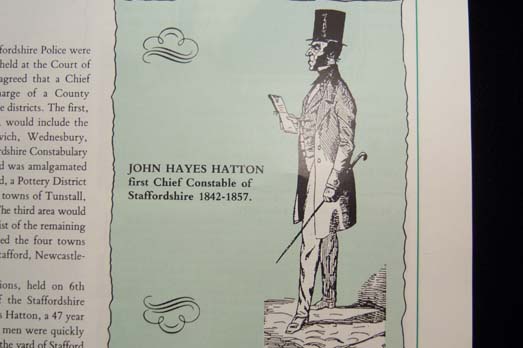 0
0 -
Hello everyone,
Here is a lapel pin commemorating the 150th Anniversary of the Stafford Police in 1992. The pin measures 18.5mm wide and 24.5mm in height. On the back is marked JEEVES Co, WATERLOO LIVERPOOL and is held in place by a standard lapel spike with round spring catch as is found on almost all lapel pins today.
The enamel work is in perfect condition and the pin itself is in mint condition. This is probably no surprise as if it is the same in the UK as here these pins would have been handed out by the hundreds and many probably never seen any wear but instead ended up in a drawer somwhere.
As a short history of the founding of the Staffordshire Police here is an exerpt from the Commemorative magazine from 1992.
October 1842
The foundations of the modern Staffordshire Police were laid in October 1842 at a meeting held at the Court of Quarter Sessions at Stafford. There is was agreed that a Chief Constable should be appointed to take charge of a County Constabulary which would be divided into three districts. The first, a Mining District in the south of the county, would include the towns of Bilston, Willenhall, West Bromwich, Wednesbury, Smethwick and Handsworth. The South Staffordshire Constabulary had been formed in 1840 to police this area and was amalgamated with the new Force on its formation. The second, a Pottery District in the north, would encompass the six pottery towns of Tunstall, Burslem, Hanley, Stoke, Fenton and Longton. The third area would be known as the Rural District and would consist of the remaining areas of the county. This arrangement excluded the four towns which already had an established police force: Stafford, Newcastle-under-Lyme, Walsall and Tamworth.
More later on the first Chief Constable of Staffordshire.
 0
0 -
Here are three brassards form my collection. These were issued to the Special Constables and are made of aluminum. I understand these are quite generic and were used by many different municipalities. There is a round version that I believe has the city crest (I forget the city's name at the moment) and it seems that every time I see one for sale I am low on collecting funds. Such is the plight of a collector. <img src="http://gmic.co.uk/public/style_emoticons/<#EMO_DIR#>/rolleyes.gif" style="vertical-align:middle" emoid="
 " border="0" alt="rolleyes.gif" />
" border="0" alt="rolleyes.gif" /> Regards
Brian
Here is yet another brassard like the ones above. I've added this to the collection only because of the four digit number. I noticed that I have omitted any information regrading these in the post abouve so I'll do that now.
These aluminum brassards were made by HIATT & Co. B'HAM (Birmingham), this is stamped in the middle of the border along the front bottom of the brassard. The full width along a horizontal plane between the loops is 102mm and 58mm in height at the loops. The badge proper, that is to say where the information is displayed, measures 83mm, again along a horizontal plane, and 52mm in height. The thickness is 3mm. Now if I can find a single digit number I will be in Special Constabulary memorabilia heaven.

Regards
Brian
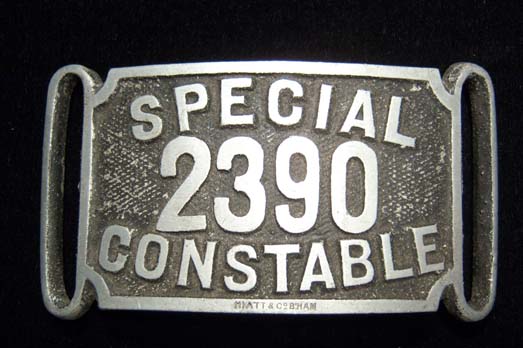 0
0 -
Many thanks for the information everyone.
I based my dating as WW I due to the hand engraving, which is not very scientific on my part, a guess really.
Thanks again.
Brian
0 -
Hi, Brian, just to give you 2 more Staffordshire items to look for there are 2 other types of Staffs whistles. The first is the acme thunderer type with the side panels covered with the tops of staffs buttons. The other that I haven't seen and is described as very rare is described as an oval whistle with a crest attached to a porteous top. Cheers Ian
Hi Ian,
That's good to know, now the search continues.
Regards
Brian
0 -
Here's an interesting trio from Independent India.They are named to:
054498 K WM3/MCWM1 THAKUR ONKAR SINGH I.N.
His medals are as follows:
30 Years Long Service Medal: 054498 K THAKUR ONKAR SINGH MCWM1 IN
20 Years Long Service Medal: 054498 WM3, T.O.SINGH, IN
9 Years Long Service Medal: Unnamed
WM3 = Weapons Mechanic 3rd class
MCWM1 = Master Chief Weapons Mechanic 1st class
IN = Indian Navy
I have no ideas what the "K" stands for.
There is little doubt that this sailor would have had more medals than just the 20 and 30 Years Long Service Medals, I have added the 9 Years LS Medal to round out the group. So, other than his occupation, rank and the fact that he was a member of the Navy there's not a lot to tell about the man from this little group. It's still nice to see a group such as this showing the years of service. This is one of my court mounts as the medals arrived loose.
Regards
Brian
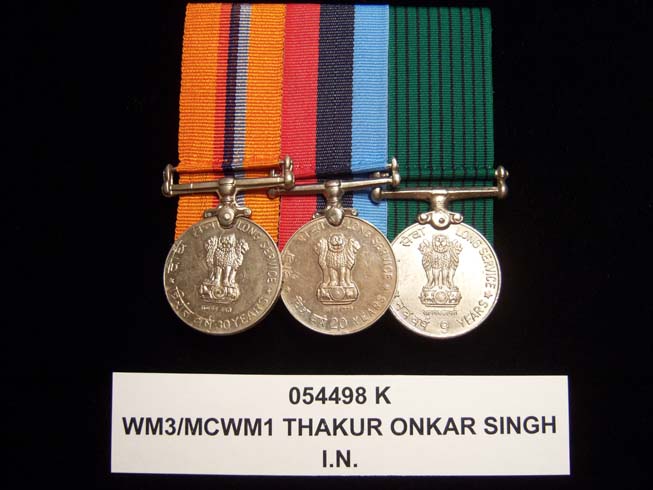 0
0 -
MErvin,
Very nice pistols! Thanks for sharing and posting so much information.
Brian,
Don't be mean with your wife. To find a woman who enjoys firearms (no matter what model) is a blessing!
Greetings,
Douglas
As if I could ever tell her what to do!

And yes she is a treasure.
Regards
Brian
0 -
Very nice pair Darrell, two of my favourite medals.
I've always thought this to be one of the most interesting periods in British Empire history.
Thanks for posting them.
Regards
Brian
0 -
In the past, everything was better (of course). I remember logging on to eBay early 2006 and there just being too much good stuff to all bid on. Logging on to GMIC each day and seeing new posts with new variations, types, and sometimes even the first picture close-up of a rare item.
Ah those good old days...
Will things get better again?
Hi Bob,
Looking for good items on eBay is like going to the same antiques mall week after week. Not much chamges and you get a little tired of the some old-same old, even some of the better shows for both antiques and militaria are like that. At first it seems like there is no end of great items but then after your collection grows there is less and less that intertests you.
GMIC has also changed quite a bit even since I joined up. Members have come and gone, some with little impact and there are others who have added greatly to the forum. I like where we are at the moment and quite often think this would be a good "place" in time to stay but everything changes and with luck for the better. I used to think the GMIC was as good as it could get, WRONG!, I think it has improved with that passing of time and the changes it has brought. I'm not talking about the format, though I really like it, I mean the present members. They are all very helpful and can take a joke. Well...except for that guy in Quebec who needs to move to Ontario and lighten up.
 Only kidding Frank, your cool...but Ontario is the place to live.
Only kidding Frank, your cool...but Ontario is the place to live. 
Will eBay improve? No, if your not already doing so, you'll end up like me and purchse the bulk of your new items from private dealers and collectors.
Will the GMIC improve? I think there's a good chance of that. The future members will make that determination. From the forum's track record I think it will only get better.
Ah, Sunday morning and too much coffee = long rants.

Regards
Brian
0 -
My wife is in love with these and would like to start a collection, I will NOT show her this post! Everytime we visit a gun show she stopes and looks at the displays of pocket pistols and says she would like to collect them. Here in Canada you do not require a permit if the pistol is old enough, the exact date escapes me but a flint lock, for example, would not require permiting.
A very nice pair of pistols, thanks for posting them.
Regards
Brian
0 -
:lol:


 Spit and elbow grease!
Spit and elbow grease! 


Funny how often going back to basics works.
A very nice job indeed, well done.
Regards
Brian
0 -
Les makes some VERY good points concerning enamelled items.
Lets consider another approach and do nothing! Really, I mean it. What is on that medal, tobacco tar, rust, whatever was deposited through the lifetime of the medal. Perhaps you should consider leaving it alone. A nice like-new medal is alright but shows no character or personality.
Quick story:
I just received a group from India consisting of the India Independence Medal, 1939-45 Star, Burma Star, Defence Medal and 1939-45 War Medal. No more details as I will be posting it later. I purchased this group for many reasons but one was because it was already mounted with the original ribbons. The ribbons showed white stains from the brass polish that had been used by the recipient years ago. The stars now have a deep patina so the polish has been on the ribbons for a long time. When I received the group the dealer had disassembled the group so the shipping package could be smaller and therefore cheaper to post. I have the original ribbons but no backing board or pin attachment device. Since I like court mounting medals this is not a problem. The question is, now that they are no longer mounted do I remount using new ribbons or use the old ribbons complete with the stains? Or try to clean the ribbons. There is a post regarding this on the forum but the consiences of the respondents to the post is to NOT try to clean old ribbons. I shall proceed to mount this group using the original ribbons and the tailor's original needle holes to produce something close to the group as it was owned by the brave Havildar (same as a Sergeant) who was awarded these medals. Ok, so it was a long story.
At least consider leaving this medal as is, you may be removing some of its personality.
Regards
Brian
0 -
Thanks for the posts,
If I try your recommendations - How good a result can I expect ? poor, moderately good, good, is tobacco smoke so hard to remove ? other examples of this medal show the enamel is pearly white, mine is a long way short.
Regards
Tobacco smoke stains are extremely easy to clean so Rick's suggestion to use only a Q-tip soaked in soapy water may do the trick IF it is indeed from cigarette smoke. Just water will not likely work as the tobacco tar will repell the water so making the water "wetter", which is what soap will do, is needed. When I was cleaning the butcher's scale I mention earlier the tar, which is what it actually is, ran off as a liquid as soon as the cleaner touched it.
Think about what tobacco smoke is doing to lungs!
 End of sermon.
End of sermon. 
Regards
Brian
0 -
Hello JustinG.
This is a very nice collection to the Kreigsmarine. I like that you have displayed them so well too. It must have taken a good deal of perseverance to have put this together in what Gordon called a "relatively short time". If you don't mind sharing this information, how long did it take?
I've put together a set of Canadian hat badges to a specific WW II action and it took me three years to complete, but I admit I was not driven to complete it. Lucky for me the hat badges in my collection are not as rare as yours.
Regards and
 cheers.
cheers.Brian
0




Princely State of Patiala - an end of an era
in South Asia
Posted
This is another photo of the Maharaja as a youth. The photos are quite dark with age.